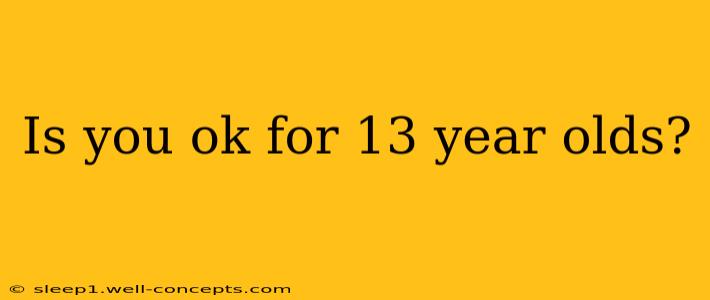Is YouTube Okay for 13-Year-Olds? A Parent's Guide to Navigating the Platform
YouTube is a ubiquitous part of modern life, offering a vast library of videos catering to diverse interests. For 13-year-olds, it presents a unique blend of opportunities and potential risks. As a parent, understanding these nuances is crucial to ensuring a safe and positive online experience for your child. This guide will delve into the complexities of YouTube's suitability for teenagers, providing practical advice for navigating this digital landscape.
The Allure and the Risks: Why YouTube is Both Attractive and Concerning for Teens
YouTube's appeal to 13-year-olds is undeniable. It offers:
- Entertainment: From music videos and comedy skits to gaming playthroughs and educational content, YouTube caters to a wide range of tastes. This diverse content makes it a highly engaging platform.
- Community: Many teens find connection and community through YouTube, engaging with creators and fellow viewers through comments and live streams. This fosters a sense of belonging.
- Learning: YouTube boasts an incredible wealth of educational content, from academic tutorials to how-to videos and documentaries. It can be a powerful learning tool when used responsibly.
However, alongside these benefits are significant risks:
- Inappropriate Content: YouTube's algorithm, while sophisticated, isn't perfect. There's a risk of encountering inappropriate content, including violence, hate speech, and sexually suggestive material.
- Cyberbullying: The anonymity afforded by the internet can embolden cyberbullying behavior. Teens can be vulnerable to online harassment and negativity.
- Time Consumption: YouTube's addictive nature can lead to excessive screen time, impacting sleep, schoolwork, and overall well-being.
- Misinformation: The platform can be a breeding ground for misinformation and biased content, potentially impacting a teen's understanding of important topics.
Strategies for Safe YouTube Usage for 13-Year-Olds
Navigating these risks requires a proactive approach:
- Supervised Viewing: Initially, consider co-viewing with your child, discussing the content, and teaching them critical media literacy skills.
- YouTube Kids (for younger teens): If your child is closer to 13 than 18, YouTube Kids might provide a more controlled environment with age-appropriate content. However, it’s essential to stay aware that even YouTube Kids isn't completely foolproof.
- Restricted Mode: Enable YouTube's Restricted Mode, which filters out potentially inappropriate content. Remember that Restricted Mode is not a foolproof solution and some inappropriate content might still slip through.
- Open Communication: Encourage open communication about their YouTube viewing habits. Ask them about the videos they watch, the creators they follow, and their overall experiences.
- Monitor Activity: While respecting privacy, you can use parental control apps or features to monitor their online activity and screen time.
- Teach Critical Thinking: Equip your teen with the skills to critically evaluate information and identify misinformation. Encourage skepticism and fact-checking.
- Set Boundaries: Establish clear rules and boundaries regarding screen time and online usage. Consistency and clear expectations are key.
- Focus on Positive Content: Help your child find channels and creators that provide positive, educational, or entertaining content that aligns with your family's values.
Conclusion: A Balanced Approach to YouTube for Teenagers
YouTube can be a valuable tool for learning, entertainment, and social connection for 13-year-olds. However, its potential downsides demand a cautious and proactive approach from parents. By employing the strategies outlined above, parents can help their teens enjoy the positive aspects of YouTube while mitigating the risks and fostering responsible digital citizenship. Remember that open communication, ongoing guidance, and a collaborative approach are crucial to navigating this ever-evolving digital landscape.

